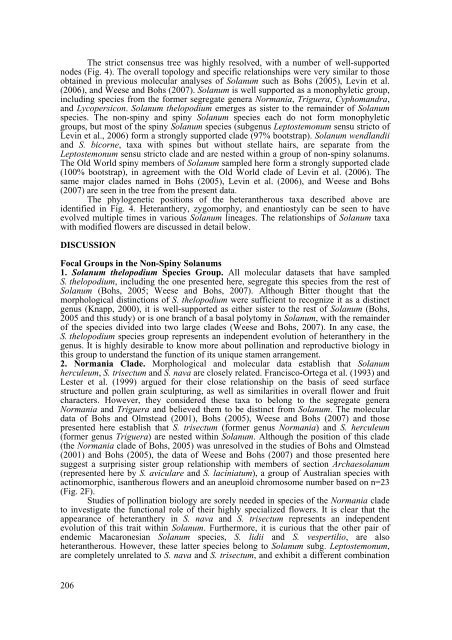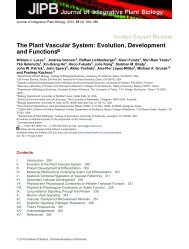Zygomorphy and heterandry in Solanum in a phylogenetic context
Zygomorphy and heterandry in Solanum in a phylogenetic context
Zygomorphy and heterandry in Solanum in a phylogenetic context
Create successful ePaper yourself
Turn your PDF publications into a flip-book with our unique Google optimized e-Paper software.
The strict consensus tree was highly resolved, with a number of well-supported<br />
nodes (Fig. 4). The overall topology <strong>and</strong> specific relationships were very similar to those<br />
obta<strong>in</strong>ed <strong>in</strong> previous molecular analyses of <strong>Solanum</strong> such as Bohs (2005), Lev<strong>in</strong> et al.<br />
(2006), <strong>and</strong> Weese <strong>and</strong> Bohs (2007). <strong>Solanum</strong> is well supported as a monophyletic group,<br />
<strong>in</strong>clud<strong>in</strong>g species from the former segregate genera Normania, Triguera, Cyphom<strong>and</strong>ra,<br />
<strong>and</strong> Lycopersicon. <strong>Solanum</strong> thelopodium emerges as sister to the rema<strong>in</strong>der of <strong>Solanum</strong><br />
species. The non-sp<strong>in</strong>y <strong>and</strong> sp<strong>in</strong>y <strong>Solanum</strong> species each do not form monophyletic<br />
groups, but most of the sp<strong>in</strong>y <strong>Solanum</strong> species (subgenus Leptostemonum sensu stricto of<br />
Lev<strong>in</strong> et al., 2006) form a strongly supported clade (97% bootstrap). <strong>Solanum</strong> wendl<strong>and</strong>ii<br />
<strong>and</strong> S. bicorne, taxa with sp<strong>in</strong>es but without stellate hairs, are separate from the<br />
Leptostemonum sensu stricto clade <strong>and</strong> are nested with<strong>in</strong> a group of non-sp<strong>in</strong>y solanums.<br />
The Old World sp<strong>in</strong>y members of <strong>Solanum</strong> sampled here form a strongly supported clade<br />
(100% bootstrap), <strong>in</strong> agreement with the Old World clade of Lev<strong>in</strong> et al. (2006). The<br />
same major clades named <strong>in</strong> Bohs (2005), Lev<strong>in</strong> et al. (2006), <strong>and</strong> Weese <strong>and</strong> Bohs<br />
(2007) are seen <strong>in</strong> the tree from the present data.<br />
The <strong>phylogenetic</strong> positions of the heterantherous taxa described above are<br />
identified <strong>in</strong> Fig. 4. Heteranthery, zygomorphy, <strong>and</strong> enantiostyly can be seen to have<br />
evolved multiple times <strong>in</strong> various <strong>Solanum</strong> l<strong>in</strong>eages. The relationships of <strong>Solanum</strong> taxa<br />
with modified flowers are discussed <strong>in</strong> detail below.<br />
DISCUSSION<br />
Focal Groups <strong>in</strong> the Non-Sp<strong>in</strong>y <strong>Solanum</strong>s<br />
1. <strong>Solanum</strong> thelopodium Species Group. All molecular datasets that have sampled<br />
S. thelopodium, <strong>in</strong>clud<strong>in</strong>g the one presented here, segregate this species from the rest of<br />
<strong>Solanum</strong> (Bohs, 2005; Weese <strong>and</strong> Bohs, 2007). Although Bitter thought that the<br />
morphological dist<strong>in</strong>ctions of S. thelopodium were sufficient to recognize it as a dist<strong>in</strong>ct<br />
genus (Knapp, 2000), it is well-supported as either sister to the rest of <strong>Solanum</strong> (Bohs,<br />
2005 <strong>and</strong> this study) or is one branch of a basal polytomy <strong>in</strong> <strong>Solanum</strong>, with the rema<strong>in</strong>der<br />
of the species divided <strong>in</strong>to two large clades (Weese <strong>and</strong> Bohs, 2007). In any case, the<br />
S. thelopodium species group represents an <strong>in</strong>dependent evolution of heteranthery <strong>in</strong> the<br />
genus. It is highly desirable to know more about poll<strong>in</strong>ation <strong>and</strong> reproductive biology <strong>in</strong><br />
this group to underst<strong>and</strong> the function of its unique stamen arrangement.<br />
2. Normania Clade. Morphological <strong>and</strong> molecular data establish that <strong>Solanum</strong><br />
herculeum, S. trisectum <strong>and</strong> S. nava are closely related. Francisco-Ortega et al. (1993) <strong>and</strong><br />
Lester et al. (1999) argued for their close relationship on the basis of seed surface<br />
structure <strong>and</strong> pollen gra<strong>in</strong> sculptur<strong>in</strong>g, as well as similarities <strong>in</strong> overall flower <strong>and</strong> fruit<br />
characters. However, they considered these taxa to belong to the segregate genera<br />
Normania <strong>and</strong> Triguera <strong>and</strong> believed them to be dist<strong>in</strong>ct from <strong>Solanum</strong>. The molecular<br />
data of Bohs <strong>and</strong> Olmstead (2001), Bohs (2005), Weese <strong>and</strong> Bohs (2007) <strong>and</strong> those<br />
presented here establish that S. trisectum (former genus Normania) <strong>and</strong> S. herculeum<br />
(former genus Triguera) are nested with<strong>in</strong> <strong>Solanum</strong>. Although the position of this clade<br />
(the Normania clade of Bohs, 2005) was unresolved <strong>in</strong> the studies of Bohs <strong>and</strong> Olmstead<br />
(2001) <strong>and</strong> Bohs (2005), the data of Weese <strong>and</strong> Bohs (2007) <strong>and</strong> those presented here<br />
suggest a surpris<strong>in</strong>g sister group relationship with members of section Archaesolanum<br />
(represented here by S. aviculare <strong>and</strong> S. lac<strong>in</strong>iatum), a group of Australian species with<br />
act<strong>in</strong>omorphic, isantherous flowers <strong>and</strong> an aneuploid chromosome number based on n=23<br />
(Fig. 2F).<br />
Studies of poll<strong>in</strong>ation biology are sorely needed <strong>in</strong> species of the Normania clade<br />
to <strong>in</strong>vestigate the functional role of their highly specialized flowers. It is clear that the<br />
appearance of heteranthery <strong>in</strong> S. nava <strong>and</strong> S. trisectum represents an <strong>in</strong>dependent<br />
evolution of this trait with<strong>in</strong> <strong>Solanum</strong>. Furthermore, it is curious that the other pair of<br />
endemic Macaronesian <strong>Solanum</strong> species, S. lidii <strong>and</strong> S. vespertilio, are also<br />
heterantherous. However, these latter species belong to <strong>Solanum</strong> subg. Leptostemonum,<br />
are completely unrelated to S. nava <strong>and</strong> S. trisectum, <strong>and</strong> exhibit a different comb<strong>in</strong>ation<br />
206
















